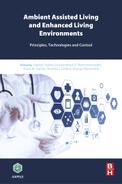Book Description
Ambient Assisted Living and Enhanced Living Environments: Principles, Technologies and Control separates the theoretical concepts concerning the design of such systems from their real-world implementations. For each important topic, the book bridges theory and practice, introducing the instruments needed by professionals in their activities.
To this aim, topics are presented in a logical sequence, with the introduction of each topic motivated by the need to respond to claims and requirements from a wide range of AAL/ELE applications. The advantages and limitations of each model or technology are presented through concrete case studies for AAL/ELE systems.
The book also presents up-to-date technological solutions to the main aspects regarding AAL/ELE systems and applications, a highly dynamic scientific domain that has gained much interest in the world of IT in the last decade. In addition, readers will find discussions on recent AAL/ELE technologies that were designed to solve some of the thorniest business problems that affect applications in areas such as health and medical supply, smart city and smart housing, Big Data and Internet of Things, and many more.
- Introduces readers to technologies supporting the development of Ambient Assisted Living applications
- Explains state-of-the-art technological solutions for the main issues regarding AAL and Enhanced Living Environments
- Reports the development process of scientific and commercial applications and platforms that support AAL and ELE
- Identifies the advanced solutions in the context of Enhanced Living Environments
